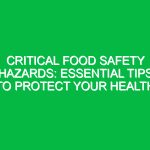Introduction
Good morning, team! Today, we’re here for our toolbox talk to discuss a critical mindset that can affect our Safety on the job: the thought of “It Won’t Happen to Me.” This phrase often encapsulates the notion that accidents and injuries are something that happens to others, not to us. However, adopting such a mindset can lead to complacency and, ultimately, to preventable accidents. Our goal today is to break down this thinking, emphasize the importance of Safety vigilance, and share practical insights to foster a safer working Environment.
The Dangers of Complacency
When we hear someone say, “It Won’t Happen to Me,” it often comes from a place of overconfidence or a lack of awareness regarding risks. Let me share a quick story: a colleague in another department once told me he didn’t need to wear his Safety Goggles because he had never had an incident before. Unfortunately, during a routine task, he ended up with debris in his eye, resulting in a painful injury and time off work. This incident serves as a stark reminder that accidents can happen to anyone, regardless of their experience or confidence level.
Understanding the Risks
Every job site presents unique Hazards, and it’s vital to recognize that these risks can affect anyone. Here are some common Hazards we may encounter:
- Slips, Trips, and Falls: These are among the most common workplace accidents. Uneven surfaces, wet floors, and clutter can easily lead to injuries.
- Equipment Accidents: Improper use of machinery or failure to adhere to safety protocols can lead to severe injuries.
- Exposure to Hazardous Materials: Working with chemicals or other hazardous substances can pose serious health risks if not handled correctly.
- Manual Handling Injuries: Lifting heavy items without proper technique can lead to strains and other musculoskeletal injuries.
Recognizing these hazards is the first step towards Prevention. By acknowledging that “It Could Happen to Me,” we can adopt safer work practices.
Real-Life Examples
Let’s look at a couple of real-life scenarios that illustrate how dismissing safety can have dire consequences:
- Construction Site Accident: A worker ignored the need for a harness while working on a scaffold, believing that he had worked at heights many times without incident. He fell and sustained serious injuries, impacting not only his life but also the project timeline.
- Warehouse Injury: An employee decided to skip using the proper lifting techniques while moving heavy boxes, claiming he had done it many times before. This led to a back injury that required extensive treatment and time off work.
Implementing Safety Measures
To combat the “It Won’t Happen to Me” mentality, we must actively implement Safety Measures. Here are some key strategies:
1. Training and Awareness
Regular Training sessions are essential in ensuring everyone is aware of the potential hazards and knows how to mitigate them. Make sure you attend all scheduled safety training and refreshers. Engage with the material, ask questions, and share your own experiences to help your colleagues learn.
2. Use of Personal Protective Equipment (PPE)
Wearing appropriate PPE is non-negotiable. This includes helmets, gloves, goggles, and any other gear specific to your job. Remember, it’s not just about compliance; it’s about protecting yourself and your colleagues. Ask yourself before starting a task: “Am I equipped for this?”
3. Conducting Risk Assessments
Before starting any task, perform a risk assessment. Identify potential hazards and create a plan to address them. This proactive approach helps in recognizing that accidents can occur and prepares us to avoid them.
4. Open Communication
Encourage a culture of safety where team members feel comfortable discussing hazards and reporting unsafe conditions. If you see something, say something! It’s through communication that we can prevent accidents and learn from each other’s experiences.
Compliance and Regulations
Adhering to health, safety, and environmental regulations is not just a legal obligation; it’s a commitment to our well-being. Familiarize yourself with the relevant legislation and company policies that govern our work. Understanding these regulations can help reinforce the need for safety practices and the consequences of neglecting them.
Key Regulations to Know
- Occupational Safety and Health Administration (OSHA): osha sets and enforces Standards to ensure safe working conditions.
- Environmental Protection Agency (EPA): The EPA regulates hazardous materials and waste management to protect the environment and public health.
- Company Safety Policies: Each organization has its own Safety Guidelines that you should be familiar with and follow diligently.
Encouraging a Safety Culture
We all play a role in fostering a culture of safety. Here are some ways to contribute:
1. Lead by Example
Your actions speak volumes. By consistently following safety protocols, you set the standard for others. If you prioritize safety, it encourages your colleagues to do the same.
2. Share Your Experiences
Sharing personal experiences, whether they are near misses or lessons learned, can be powerful. It helps others realize that accidents happen and that vigilance is crucial.
3. Acknowledge and Reward Safe Behavior
Recognize and reward Safe Practices among your peers. Positive reinforcement can go a long way in promoting a safety-first mentality.
Open Discussion
Before we wrap up, let’s take a moment to discuss. What are some safety practices you think are essential? Have you ever encountered a situation where you or someone else thought, “It Won’t Happen to Me”? How did it turn out?
Conclusion
In conclusion, the mindset of “It Won’t Happen to Me” can be a dangerous trap. We’ve explored the risks, shared real-life examples, and discussed practical safety measures to counteract complacency. Remember, safety is not just an individual responsibility but a team commitment. Let’s work together to foster a culture where safety comes first, and we look out for one another.
Thank you for your attention today and for your ongoing commitment to maintaining a safe working environment. Let’s make this a safe day on the job!


